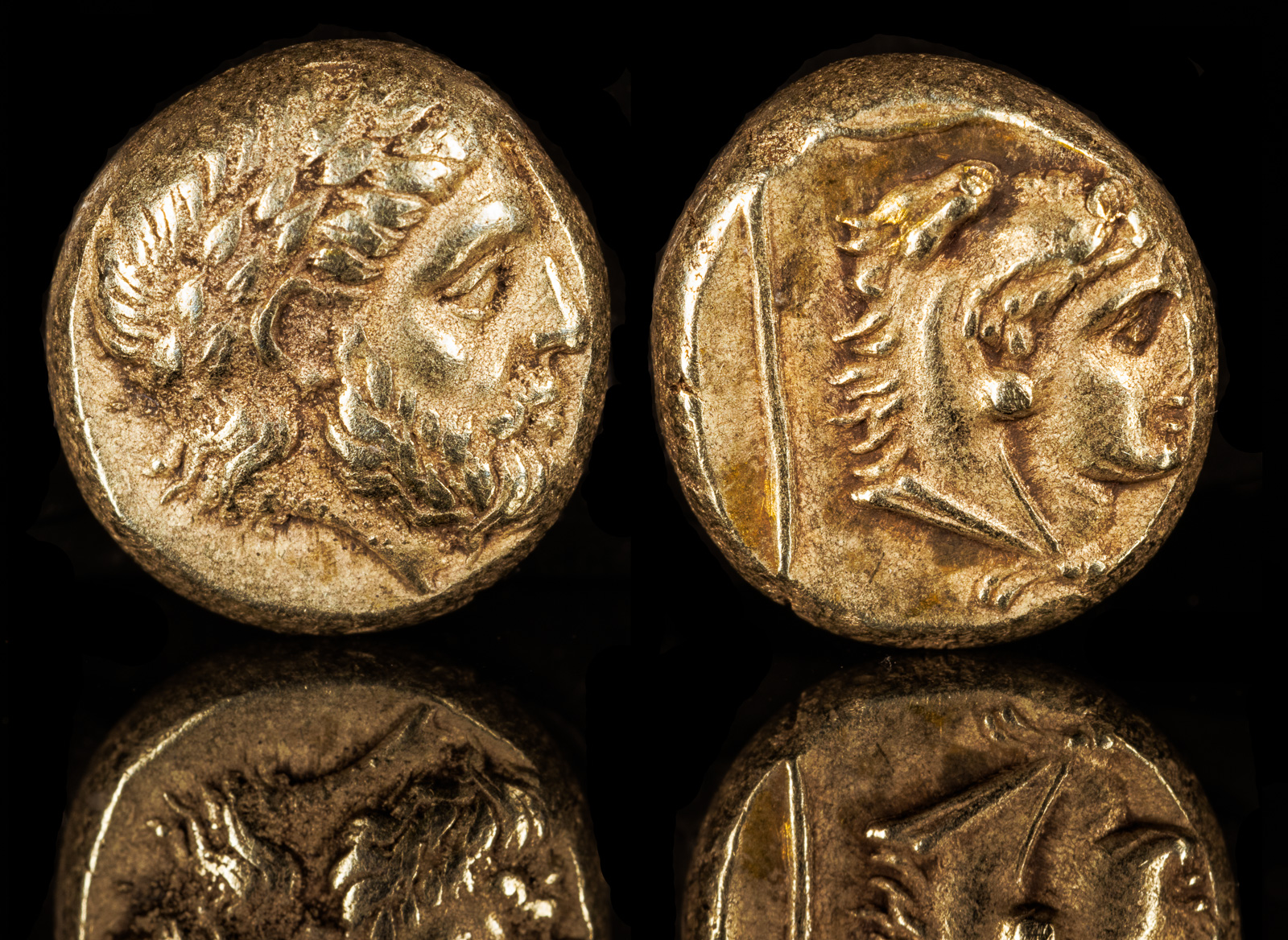
Mytilene EL Hekte c. 332 BCE
10.5mm 2.57g 12h
Avers : Tête laurée et barbue de Zeus à droite (Philippe II de Macédoine).
Revers : Tête imberbe d’Héraklès à droite coiffée de la léonté dans un carré linéaire (Alexandre III le Grand).
Bod.103 – B. traité- – Aulock1711 – P.- – BMC.- – Cop.- – HGCS. 5/1029 (R2)
I truly had no intentions to pick up an electrum coin. I have a regimented system of only picking up coins from the time of Philip II, Alexander III, or the Wars of the Diadochi. So, when going through the Greek coins in auctions, I typically admire the first few such coins for their beauty, then scroll past them.
But this one made me pause. Philip II (Zeus) and Alexander III (Herakles) referenced on one coin? Oh oh.
Mytilene had some history of supporting the Macedonian kings. In fact, this isn’t the first coin to depict the Zeus image made so famous on Philip II‘s coins (see Bodenstedt 101c and Aulock 1710 among others). In a huge stroke of luck to Alexander, his top enemy in the field, Memnon of Rhodes, died during a siege of Mytilene. It’s believed that these coins were minted just after the Persians were ousted again in 333 BCE.
The electrum coinage of Mytilene is varied. It certainly seems that altering dies to fit the current political climate was a common practice. For example, earlier issues depicted the same Athenian owl as made famous on some of their tets and decadrachms (see Bodenstedt 105). Others referenced both Athens and Persia (see Bodenstedt 71).
So, it wasn’t completely out of the ordinary for Mytilene to mint such a coin. Still, from what I found, only two coins in history referenced both Alexander and his father on one coin. There’s this one, and a slightly less rare obol from Cilicia (SNG Levante 198).
The exact rarity of this coin is difficult to say. Bodenstedt stated there were five known copies, with three different dies on the obverse and three on the reverse. Clearly there are more than that. Acsearch.info enumerates 11 sales within the last 18 years. Five of those were from Leu and three from Lanz (but the latest was 2007). Based on Bodenstedt’s previous comment, I’m guessing there are 20 to 25.
Two personal observations from looking at this coin and the others sold in the past years.
1) The centering seems to be bad across every one. Not a single coin looked perfect. While it certainly must have been difficult to center such a tiny coin, and off-centered Mytilene hekte are common, this series seems to have a lot more mistakes than normal.
2) In my opinion, the die with Herakles looks rougher than that of Zeus.
I therefore wonder whether this coinage was minted in a hurry. My suspicion is a die study would find some overlap between the previous Zeus issues above, and this series. Another explanation is a loss of mint workers during Memnon’s siege. The replacements weren’t as skilled in centering these tiny coins, so they made more mistakes.
Regardless whether these were minted in a hurry, they weren’t produced for long. Alexander supposedly put an end to Mytilene electrum production around 330 BCE, and afterwards they switched to the well-known Alexander tets. As I understand, this was therefore likely the last electrum coinage from Mytilene. While Alexander usually stopped independent coinage in his territories, there were exceptions. For example, many cities in Ionia minted small coinage during this time. However, electrum coins probably posed too great a threat to his silver tets, so they had to stop.
For me, it’s rare to pick up issues from cities vs specific rulers. I would go crazy trying to collect every single city that was impacted by Alexander the Great or the Diadochi, so I only pick up those who played a crucial part or those named after major players. Mytilene meets neither criteria, but by their stunning move to reference both Philip II and Alexander III, I didn’t need to think long about the purchase.
According to Athenaios, the Mytileans “refer to the sweet wine produced in their country as prodromos (front-runner), whereas others call it protropos (allegedly from the word for ‘sea-weed’)
Neandria is founded by Aeolians from Mytilene.
Estimated foundation of Kolone, probably by settlers from Mytilene.
Death of Erinna of Telos in Mytilene.
Mytilene recaptures Sigeion.
The Battle of Lade is fought between the Ionians under Dionysos of Phokaia and the Persians. Chios has the largest contingent, followed by Miletos, Lesbos (probably Mytilene), Samos, Teos, Priene, Erythrai, Myos, and Phokaia. Most fled during the battle, but the Chians put up a bold resistance before defeat.
The fortifications of Pyrrha are reinforced by Mytilene.
Athens detaches Kolone , Ophrynion, and Larissa Ptolemais from Mytilene in punishment for their revolt.
Antandros is taken by exiles from Mytilene.
Peloponnesian War ends in an Athenian surrender, and as a result Adramytteion is ruled by Mytilene. Residents of Aegina are allowed to return to their island.
Eresos, Byzantion, Chios,Mytilene, Methymna, Rhodes, Thebes, Korkyra, Eretria, Kios, Samos, Naxos, Andros, Myrina (Lembos), Hephaistia, Imbros, and Thasos join the Second Athenian League, reaffirming its alliance with Athens in response to the growing threat of Persian interference and internal Greek conflicts.
Aristotle moves from the court of Philip II, where he was the tutor to Alexander III, to Mytilene, where his friend Theophrastos lives.
Aristotle returns to Athens from Mytilene.
Memnon of Rhodes uses a Persian fleet to secure Chios, then Antissa, Eresos, Mytilene, and Pyrrha.
Autophradates and Pharnabazos III subjugate Mytilene.
Chares is given command of Mytilene by Autophradates, but he is forced to surrender it to the Macedonians.
Memnon of Rhodes dies during a siege of Mytilene.
Mithridates VI flees to Pitane to evade Gaius Flavius Fimbria, then moves on to Mytilene.
Lucullus undertakes the Siege of Mytilene. Julius Caesar serves with him.